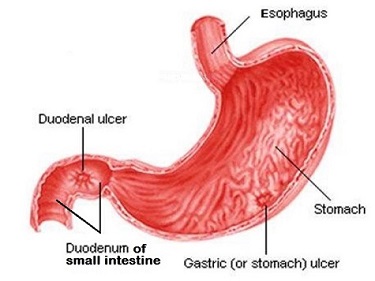Learn all about gastrinoma symptoms its causes and the treatment options. Gastrinoma is a malignant tumor of G-cells that produce the gastrin hormone. They are considered to be functionally-active tumors, because they secrete gastrin. They may be found in the pancreas or duodenum (part of the small intestine)
Management of gastrinomas can be challenging. Initial management of acute symptoms, such as gastrointestinal bleeding, can be done while performing an esophagoduodenoscopy (EGD). In addition to its therapeutic capabilities, EGD can provide useful diagnostic information: the EGD will often identify multiple ulcers within the stomach, duodenum, and jejunum. If these ulcers are actively bleeding, or have stigmata of recent bleeding, endoscopic interventions can be performed to assist in hemostasis. Potential interventions include injection of epinephrine, cauterization, and/or endoscopic clipping.
In a 2013 German epidemiologic review of 2 time periods (1976-1988 and 1998-2006) comprising more than 10.8 million people, there was an approximately 5-fold increase in cases of gastroenteropancreatic neuroendocrine tumors (GEP-NETs) between 1976 and 2006, accompanied by a change in the anatomic distribution.
Gastric carcinoids or neuroendocrine tumors are reported to account for an estimated 0.6-2% of detected gastric polyps. In the United States, the incidence of these tumors has greatly increased over the past several decades Gastrinomas are more common in males than in females, with ratios from 1.5:1 to 2:1.
There are various treatment modalities available to address Gastrinoma of Pancreas; although, a complete surgical excision is the preferred mode of treatment. In cases of metastasis, a combination of chemotherapy, radiation therapy, and surgical procedures may be used.
What is Gastrinoma?
Gastrinoma is a rare type of neuroendocrine tumour that usually develops in the gut (digestive system). A gastrinoma is a gastrin-secreting tumor that leads to ulceration and can occur in the pancreas, although it is most commonly found in the duodenum. There is hyper secretion of the HCl acid into the duodenum, which causes the ulcers. Excessive HCl acid production also causes hyper peristalsis, and inhibits the activity of lipase, causing severe diarrhea.
Gastrinoma Symptoms
The signs and symptoms of gastrinomas are related to increase gastric acid production by the neuroendocrine tumour cells. Most patients experience abdominal pain, heartburn, nausea, blood in the vomit, bleeding from the back passage and diarrhoea. On average these symptoms are present for five years prior to a definitive diagnosis of gastrinoma being established.
Gastrinomas may be present in 0.1% of patients who have ulcers in their stomach or small intestine
Other symptoms of gastrinoma include:
- Diarrhea
- Mild to severe abdominal pain
- Steatorrhoea (increased amounts of fat in the stools)
- bloating
- burping
- Nausea
- vomiting
- Weight loss
- Poor appetite
Gastrinoma Causes
Many people with gastrinomas have several tumors as part of a condition called multiple endocrine neoplasia type I (MEN I). Tumors may develop in the pituitary gland (brain) and parathyroid gland (neck) as well as in the pancreas.
Gastrinomas may occur either in a nonfamilial form (sporadic) (75%) or as part of the familial syndrome, multiple endocrine neoplasia-types 1 (MEN-1). MEN-1 is an autosomal dominant syndrome characterized by tumors or hyperplasia of multiple endocrine tissues. Hyperparathyroidism due to parathyroid hyperplasia (> 95%), pancreatic endocrine tumors (PET’s) (80–100%), anterior pituitary adenomas (16–100%), and adrenal adenomas (27–36%) are the most common. Nonfunctional PET’s (80–100%) are the most common followed by gastrinomas (54%), insulinomas (21%), and glucagonomas (3%). It is now known that MEN-1 is due to mutations in a 10-exon gene on chromosome 11q.13 which encodes for a 610 amino acid nuclear protein, MENIN, whose function is unclear. Recognition of the presence of MEN-1 is important because these patients differ from sporadic cases in the role of surgery, other management decisions, natural history, and need for genetic screening. In Zollinger-Ellison syndrome, the stomach produces far too much acid, which causes people to develop many peptic ulcers. In this syndrome, the excess acid is produced because a tumor called a gastrinoma produces gastrin. Gastrin is a hormone that stimulates the stomach to produce acid.
The gastrinoma tumor is usually found in the duodenum, pancreas, or adjacent structures. About half of the tumors are cancerous (malignant). People with Zollinger-Ellison syndrome frequently develop many peptic ulcers that recur despite treatment to control ulcer disease. They may also develop diarrhea that is difficult to control and/or symptoms of acid reflux (gastro esophageal reflux or GERD)
Gastrinoma Prognosis
Patients with hepatic metastases may have a remaining life span of less than 1 year; the 5-year survival rate is 20-30%. In patients with localized disease or metastasis to local lymph nodes without liver metastasis, the 5-year survival rate may be 90%. If the tumor is not completely removed, people have a 43% chance of surviving 5 years and a 25% chance of surviving 10 years.
Gastrinoma Treatment
Gastrinoma treatment can involve surgery or proton pump inhibitor. These drugs, which include Lansoprazole (Prevacid), omeprazole (Prilosec, Zegerid), pantoprazole (Protonix), dexlansoprazole (Dexilant), esomeprazole (Nexium), and rabeprazole (Aciphex), curb the production of stomach acid and allow the ulcers to heal.
Doctors may also prescribe medications known as H2-blockers, such as cimetidine (Tagamet), famotidine (Pepcid), and ranitidine (Zantac). However, these drugs don’t work as well to reduce stomach acid. In some cases, a patient may need surgery for the peptic ulcer or to remove the gastrinoma. Up to 50% of patients who have surgery can be cured. For malignant tumors, radiation and chemotherapy may be offered.
 Health & Care Information
Health & Care Information 


